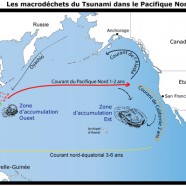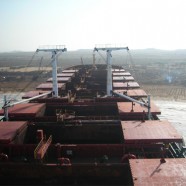Latest news : ex-Probo Koala
The Gulf Jash, ex- Probo Koala, is anchored in Halong Bay, Vietnam. Today, June 3rd GMS, U.S. based ship broker, denies ownership of the ship. Under this hypothesis, it is for Dubai based Gulf Navigation, owner of the ex- Probo Koala since 2006, to clarify the conditions of the sale and the destination of the vessel.
In accordance with Robin des Bois’ (“Robin Hood” international association based in Paris) press release published May 17th 2011, the Equasis database displays, since May 31st that the Gulf Jash ex-Probo Koala, the Gulf Ahmadi ex-Probo Bison and the Gulf Shagra ex-Probo Panda are indeed “to be broken up”.
Latest news : ex-Probo Koala
The Gulf Jash, ex- Probo Koala, is anchored in Halong Bay, Vietnam. Today, June 3rd GMS, U.S. based ship broker, denies ownership of the ship. Under this hypothesis, it is for Dubai based Gulf Navigation, owner of the ex- Probo Koala since 2006, to clarify the conditions of the sale and the destination of the vessel.
In accordance with Robin des Bois’ (“Robin Hood” international association based in Paris) press release published May 17th 2011, the Equasis database displays, since May 31st that the Gulf Jash ex-Probo Koala, the Gulf Ahmadi ex-Probo Bison and the Gulf Shagra ex-Probo Panda are indeed “to be broken up”.
Millions of Stowaway Passengers Circling Around the Pacific Ocean
The tsunami which followed the Japanese earthquake devastated around 300km of coastal cities, towns, farmlands and greenhouses along Japan’s Pacific coastline. The wave was reported to have spread up to 10km (six miles) inland and inundated around 500km². Not only did the earthquake and tsunami create an estimated 25 million tonnes of rubble, but when the tsunami receded it dragged with it countless quantities of waste in the flooded zone.
Millions of Stowaway Passengers Circling Around the Pacific Ocean
The tsunami which followed the Japanese earthquake devastated around 300km of coastal cities, towns, farmlands and greenhouses along Japan’s Pacific coastline. The wave was reported to have spread up to 10km (six miles) inland and inundated around 500km². Not only did the earthquake and tsunami create an estimated 25 million tonnes of rubble, but when the tsunami receded it dragged with it countless quantities of waste in the flooded zone.
Millions of Stowaway Passengers Circling Around the Pacific Ocean
The tsunami which followed the Japanese earthquake devastated around 300km of coastal cities, towns, farmlands and greenhouses along Japan’s Pacific coastline. The wave was reported to have spread up to 10km (six miles) inland and inundated around 500km². Not only did the earthquake and tsunami create an estimated 25 million tonnes of rubble, but when the tsunami receded it dragged with it countless quantities of waste in the flooded zone.
Probo Koala To Bangladesh: Refused
Warned by Robin des Bois as early as May 17th 2011 of the Probo Koala’s imminent arrival to be beached for demolition (1), Bangladesh authorities, through its Ministry of Environment & Forest have just closed access to the demolition shipyard to this ship whose last known name was Gulf Jash, IMO number 8309816. This is the first time a ship destined to demolition is turned away from Bangladesh waters. The decision is justified by the history of this tanker and the particularly toxic residue still possibly on board. The list of these substances and a draft of the ship can be found here.
Probo Koala To Bangladesh: Refused
Warned by Robin des Bois as early as May 17th 2011 of the Probo Koala’s imminent arrival to be beached for demolition (1), Bangladesh authorities, through its Ministry of Environment & Forest have just closed access to the demolition shipyard to this ship whose last known name was Gulf Jash, IMO number 8309816. This is the first time a ship destined to demolition is turned away from Bangladesh waters. The decision is justified by the history of this tanker and the particularly toxic residue still possibly on board. The list of these substances and a draft of the ship can be found here.
Probo Koala To Bangladesh: Refused
Warned by Robin des Bois as early as May 17th 2011 of the Probo Koala’s imminent arrival to be beached for demolition (1), Bangladesh authorities, through its Ministry of Environment & Forest have just closed access to the demolition shipyard to this ship whose last known name was Gulf Jash, IMO number 8309816. This is the first time a ship destined to demolition is turned away from Bangladesh waters. The decision is justified by the history of this tanker and the particularly toxic residue still possibly on board. The list of these substances and a draft of the ship can be found here.
All In Asia
56 pages of informations, destinations, stories and histories, pictures, on the demolition of ships around the world from January 1st to May 6th.
Of 362 ships sent to demolition during the first 4 months of the year, 332 were sent to Asia; 123 belonging to European ship owners and 134 were built in Europe.
Despite the poor working conditions, the devastated environment, and many hazardous wastes, the shipping world continued as usual to leave their discarded hulls on the Asian beaches.
Probo Koala : The Death Boat heading to the Cemetery
The Probo Koala vessel which spread death and panic in Abidjan during the summer of 2006 has just been sold by her last owner to a demolisher in Bangladesh for $ 7.7 million. Currently off the coast of China, she should be beached in Chittagong under the name of Gulf Jash within the next few days. The Greek owner had in fact sold the Probo Koala to Gulf Navigation based in Dubai.
Built in 1989, at Korean Shipbuilding & Engineering shipyards, the Probo Koala was used by the multinational company Trafigura to produce low-grade gasoline from highly sulphurised oil off the coast of Gibraltar and Malta. The toxic residue produced by these onboard refinery operations was unloaded in August 2006 at the Abidjan port. Scattered around the Ivory Coast economic capital, the residue containing hydrogen sulphide and mercaptans caused the death of 17 people and intoxicated over one hundred thousand others, according to the official figures.











